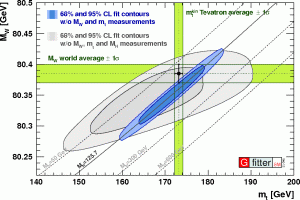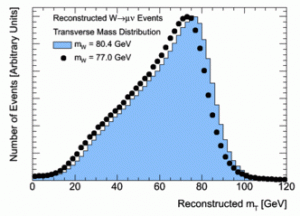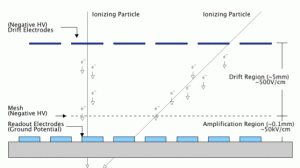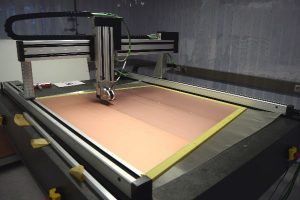Main goal of our research is the probe the Standard Model of Particle Physics with electroweak gauge bosons. To reach this goal, we pursue three different kind of activities, namely the precision measurement of the W boson mass and its width at the Large Hadron Collider, the search for axion-like particles at the ALPS-II, the BabyIAXO and the FASER experiment as well as the development and construction of new particle detectors based on Micromegas Technology.
Electroweak Precision Measurements
Modern particle physics encounters a fundamental problem. Over the past decades we have been describing particles that compose our Universe and their interactions in increasing detail. Nevertheless, there is still a big gap to fill before we are able to tell the whole story.
 We have not yet understood how elementary particles acquire their mass, or in other words, what is the role of the famous Higgs Boson. The newly discovered particle at CERN's Large Hadron Collider in July 2012, could be the long thought Higgs-Boson - or it might be something completely new beyond our todays theories. Within our theory of fundamental interactions (called Standard Model of Particle Physics), the mass of the W-Boson, the mass of the top-quark and also the mass of the Higgs-Boson are related through so-called "Quantum Loop Corrections", illustrated via Feynman diagrams on the right. These relations allow us to get a definite answer on the nature of the newly found particle, via the precision measurements of the mass of three fundamental particles, namely the W boson, the top quark and the Higgs boson candidate (see second Figure on the right).
We have not yet understood how elementary particles acquire their mass, or in other words, what is the role of the famous Higgs Boson. The newly discovered particle at CERN's Large Hadron Collider in July 2012, could be the long thought Higgs-Boson - or it might be something completely new beyond our todays theories. Within our theory of fundamental interactions (called Standard Model of Particle Physics), the mass of the W-Boson, the mass of the top-quark and also the mass of the Higgs-Boson are related through so-called "Quantum Loop Corrections", illustrated via Feynman diagrams on the right. These relations allow us to get a definite answer on the nature of the newly found particle, via the precision measurements of the mass of three fundamental particles, namely the W boson, the top quark and the Higgs boson candidate (see second Figure on the right).
Therefore, the primary goal of the our research team was to establish a dedicated research activity, focusing on precision measurements of electroweak gauge bosons at high-energy particle colliders. This is not only new research direction at the Johannes-Gutenberg University of Mainz, but within the whole of Germany. Special focus is placed on the determination of the W Boson mass aiming at a relative precision of 0.01% and superseding the current best measurements by several factors. This precision measurement will have a crucial influence on the future of high-energy physics and is not expected to be further improved in the coming years.
 The measurement is be based on the analysis of more than ten billion recorded proton-proton collisions at the ATLAS Experiment and is one of the most challenging measurements in current high energy physics. This requires innovative approaches in large-scale data-analyses, newly developed techniques to constrain theoretical and experimental uncertainties. The basic idea of the measurement is to compare Monte Carlo predicted distributions of decay-products of the W-Boson with the recorded data. The Monte Carlo predicted distributions differ only by the assumed mass of the W-Boson and hence we can identify the "real" W-Boson mass by the predicted distribution which matches best our data.
The measurement is be based on the analysis of more than ten billion recorded proton-proton collisions at the ATLAS Experiment and is one of the most challenging measurements in current high energy physics. This requires innovative approaches in large-scale data-analyses, newly developed techniques to constrain theoretical and experimental uncertainties. The basic idea of the measurement is to compare Monte Carlo predicted distributions of decay-products of the W-Boson with the recorded data. The Monte Carlo predicted distributions differ only by the assumed mass of the W-Boson and hence we can identify the "real" W-Boson mass by the predicted distribution which matches best our data.
Search for Axions and Axion Like Particles
Our group is also involved in the preparation of the ALPS-II experiment (https://alps.desy.de/e191931/) at DESY, Hamburg, which will search for axion like particles in a light-trough-the-wall type of experiment. Axions could not only explain the fine-tuning problem of QCD, but also are natural candidates for the dark matter. In the past years, we also have been leading participants at the OSQAR experiment, based at CERN, with the same goal.
 Another approach to search for Axion-Like particles is to use the potential axion-flux from the sun. This approach is used by the (BabyIAXO) Experiment (http://iaxo.web.cern.ch/content/experiment), where our group is founding member and took over responsibilities in the active muon veto system as well as the signal photon detection using Micromegas detectors.
Another approach to search for Axion-Like particles is to use the potential axion-flux from the sun. This approach is used by the (BabyIAXO) Experiment (http://iaxo.web.cern.ch/content/experiment), where our group is founding member and took over responsibilities in the active muon veto system as well as the signal photon detection using Micromegas detectors.
Axion like particles with masses above several electron volts can be searched for at the LHC: On the one hand, one can study light-by-light scattering processes and anomalous Higgs boson decays using data of the ATLAS experiment, on the other hand one can search for striking features at the upcoming FASER experiment (https://faser.web.cern.ch). Our group is currently following both approaches, funded by an ERC Consolidator Grant.
Development of Micromegas Detectors
The Micromegas technology was first proposed in 1996 and was subject to constant research, development and use from then on. The basic principle of a Micromegas detector is illustrated in the figure beside. A planar drift electrode is placed a few mm above a readout electrode.
 The gap is filled with ionization gas, e.g. a mixture of Argon and CO2. In addition, a metal mesh is placed ~0.1 mm above the readout electrode. The region between drift electrode and mesh is called the drift region, whilst the region between mesh and readout electrodes is called the amplification region. Both the mesh and the drift electrode are set at negative high voltage, so that a electric field of ~600 V/cm is present in the drift region and a field of ~50,000V/cm is present in the amplification region. The readout electrodes are set to ground potential. Charged particles traversing the drift region ionize the gas. The resultant ionized electrons drift towards the mesh, which itself appears transparent to the ionization electrons when the electric field in the amplification region is much larger than that in the drift region. Upon reaching the amplification region, the ionization electrons cause a cascade of secondary electrons (avalanche) leading to an amplification factor of ~10.000, which can be measured by the readout electrodes. The basic Micromegas design can be easily extended to a two-dimensional readout.
The gap is filled with ionization gas, e.g. a mixture of Argon and CO2. In addition, a metal mesh is placed ~0.1 mm above the readout electrode. The region between drift electrode and mesh is called the drift region, whilst the region between mesh and readout electrodes is called the amplification region. Both the mesh and the drift electrode are set at negative high voltage, so that a electric field of ~600 V/cm is present in the drift region and a field of ~50,000V/cm is present in the amplification region. The readout electrodes are set to ground potential. Charged particles traversing the drift region ionize the gas. The resultant ionized electrons drift towards the mesh, which itself appears transparent to the ionization electrons when the electric field in the amplification region is much larger than that in the drift region. Upon reaching the amplification region, the ionization electrons cause a cascade of secondary electrons (avalanche) leading to an amplification factor of ~10.000, which can be measured by the readout electrodes. The basic Micromegas design can be easily extended to a two-dimensional readout.
 The low production cost per m2 of active area, the high track resolution and the enormous rate capability make Micromegas detectors a perfect candidate for future particle detectors, but also for industrial and potential medical applications. In our group we develop new Micromegas designs and layouts, which will be used in the Upgrade of the ATLAS detector. We can test our developed detectors in our own detector laboratory. In addition, we have the responsibility to construct a large fraction of so-called drift-panels for the ATLAS Muon Spectrometer Upgrade Program. For this task, we use the infrastructure of the PRISMA Detector Laboratory.
The low production cost per m2 of active area, the high track resolution and the enormous rate capability make Micromegas detectors a perfect candidate for future particle detectors, but also for industrial and potential medical applications. In our group we develop new Micromegas designs and layouts, which will be used in the Upgrade of the ATLAS detector. We can test our developed detectors in our own detector laboratory. In addition, we have the responsibility to construct a large fraction of so-called drift-panels for the ATLAS Muon Spectrometer Upgrade Program. For this task, we use the infrastructure of the PRISMA Detector Laboratory.